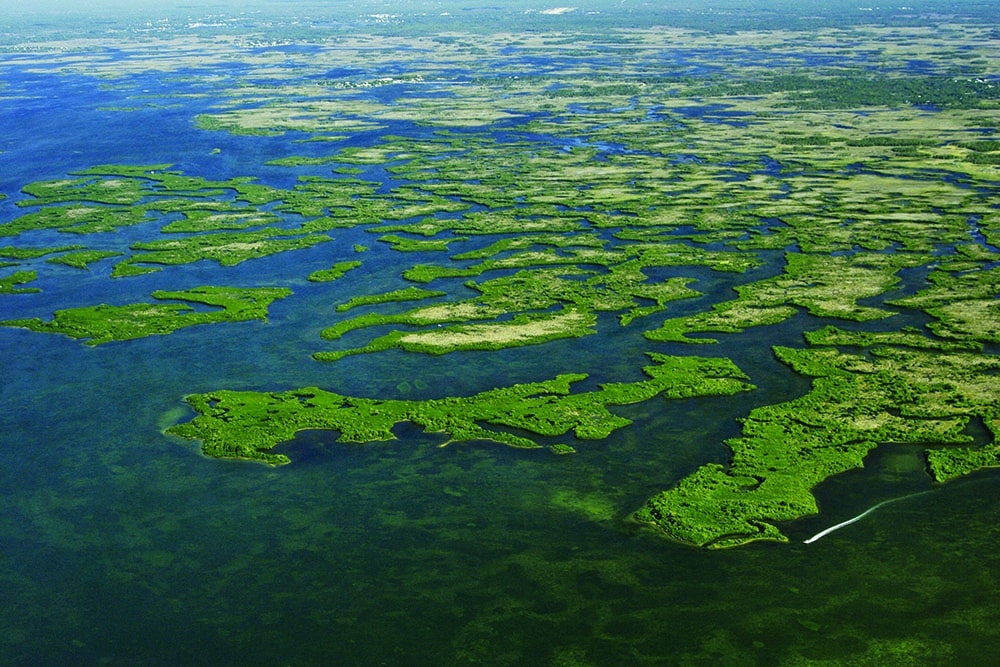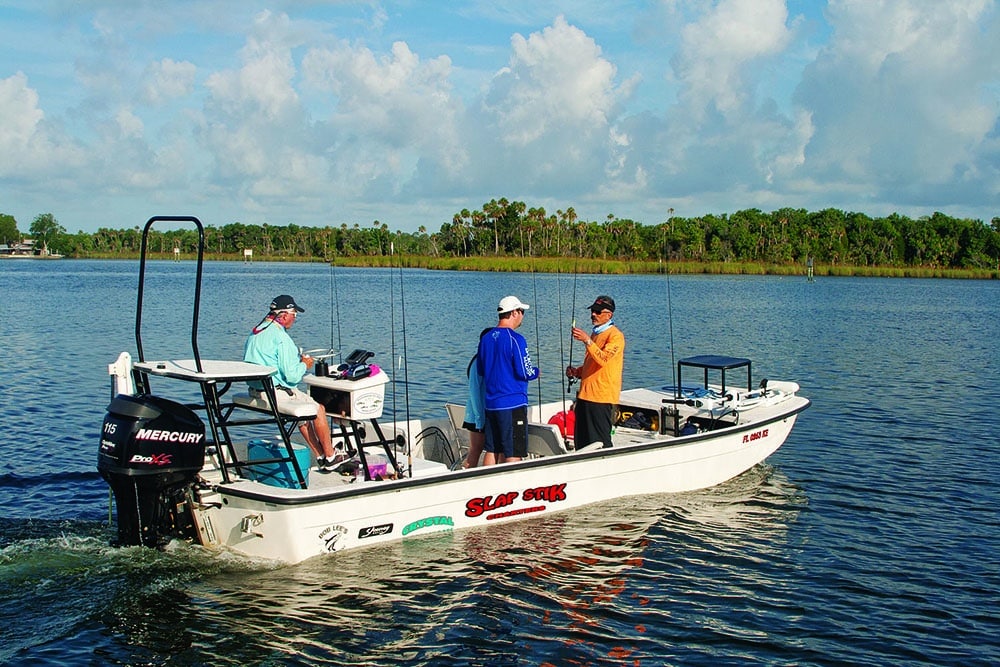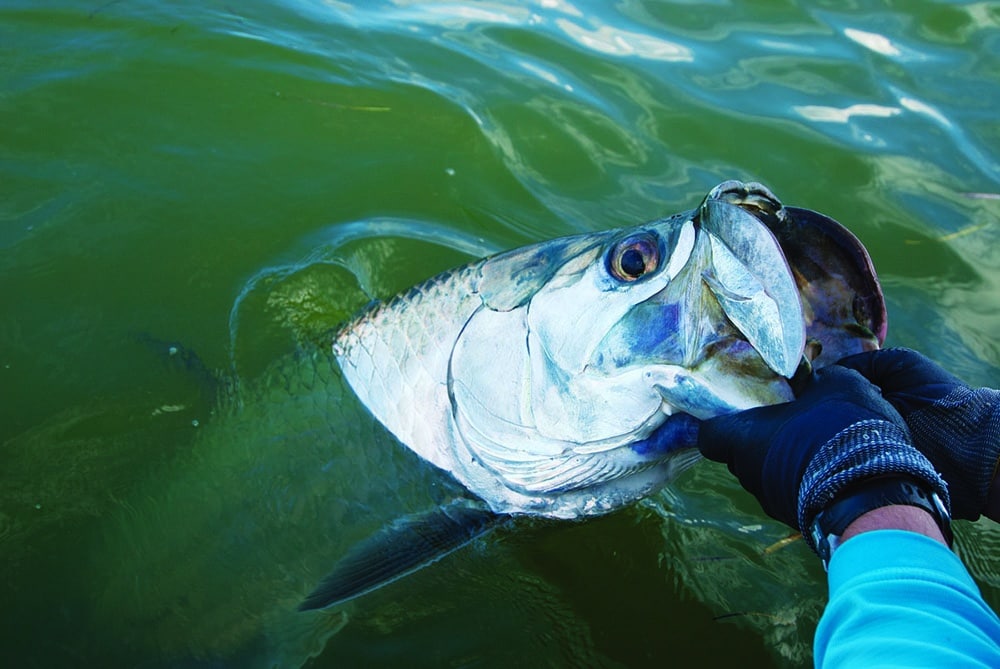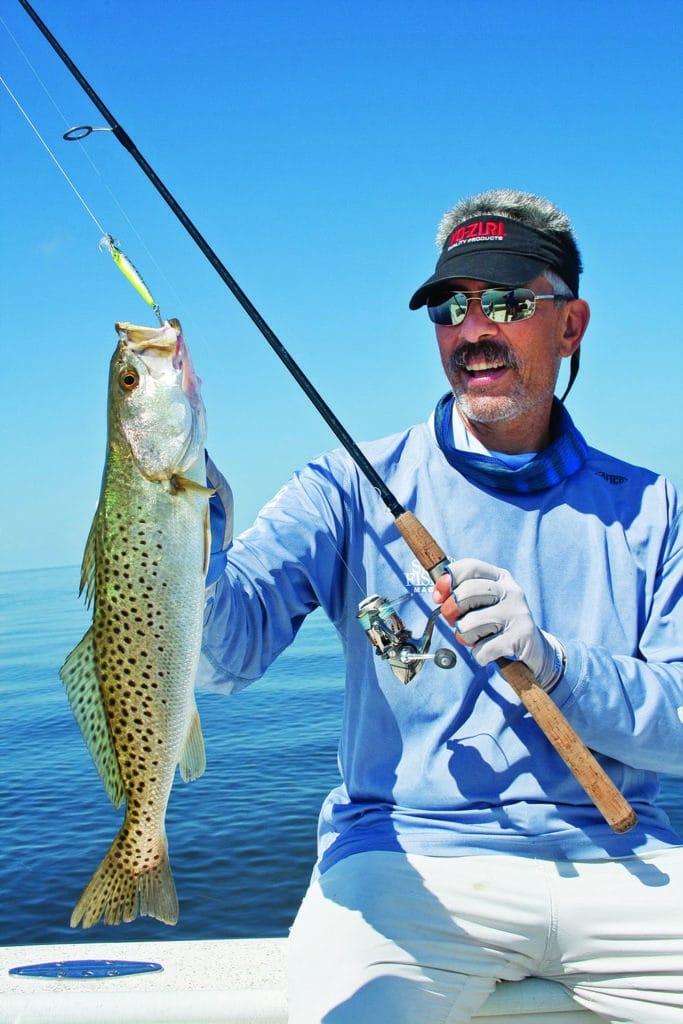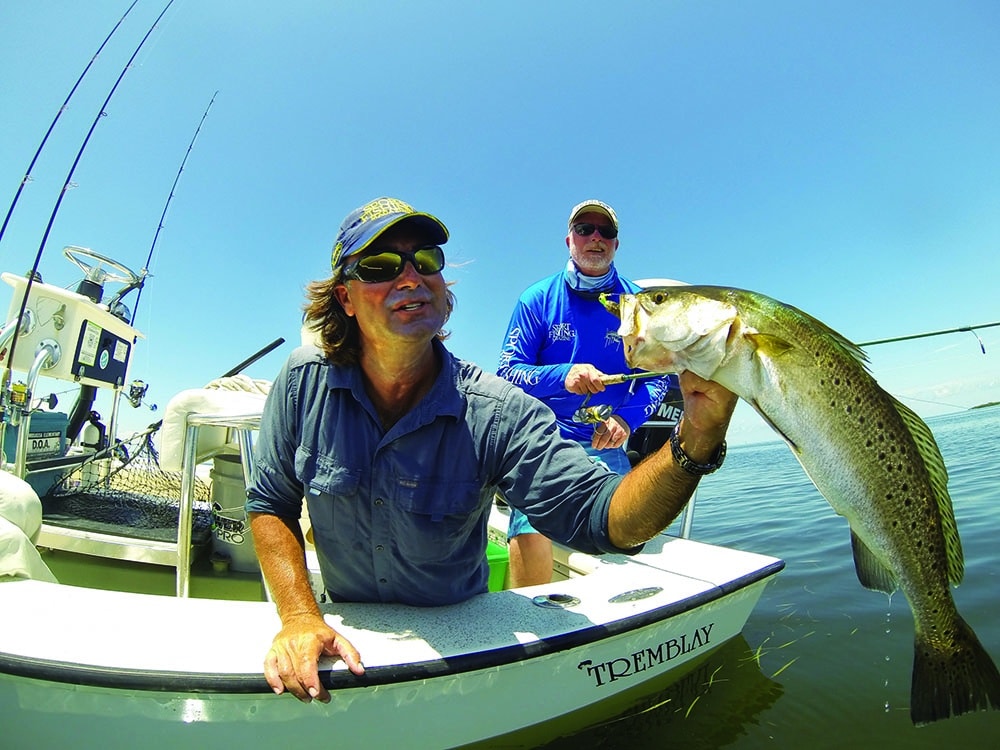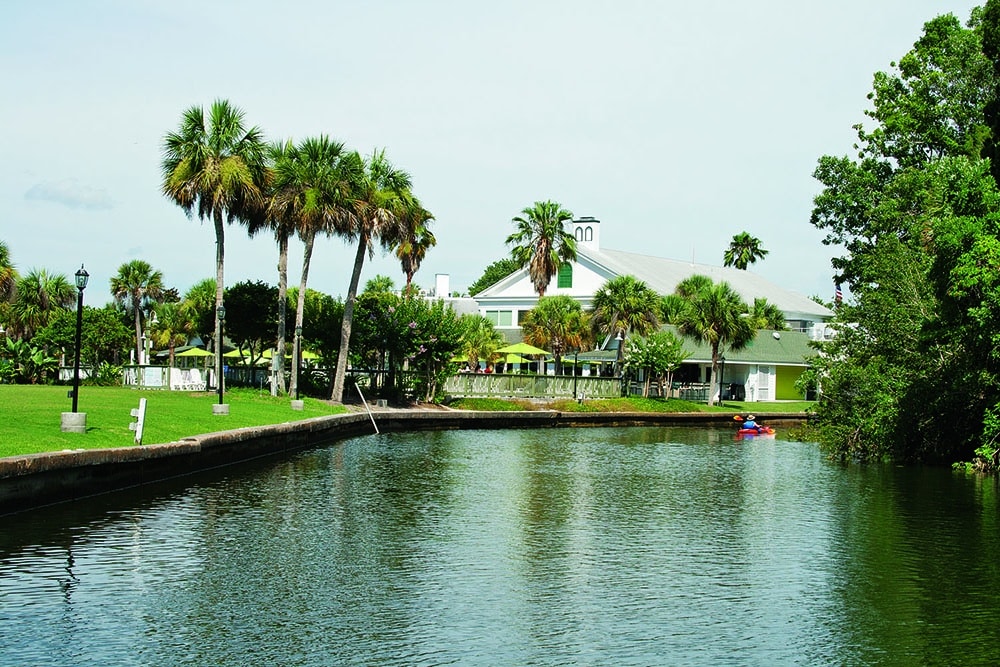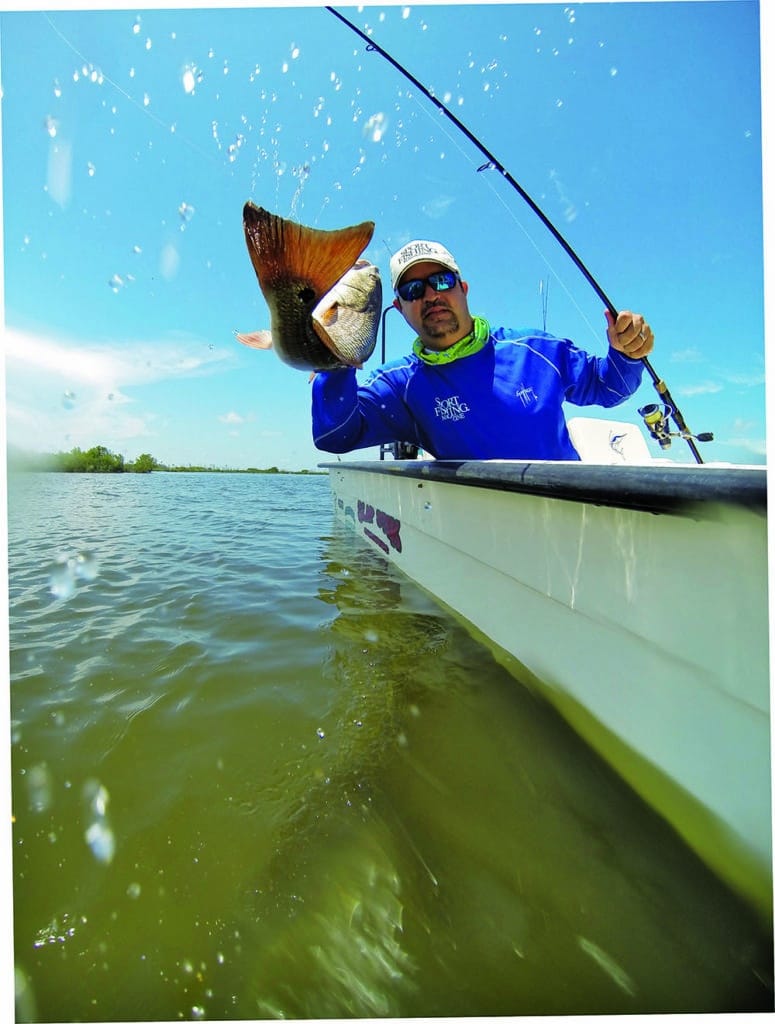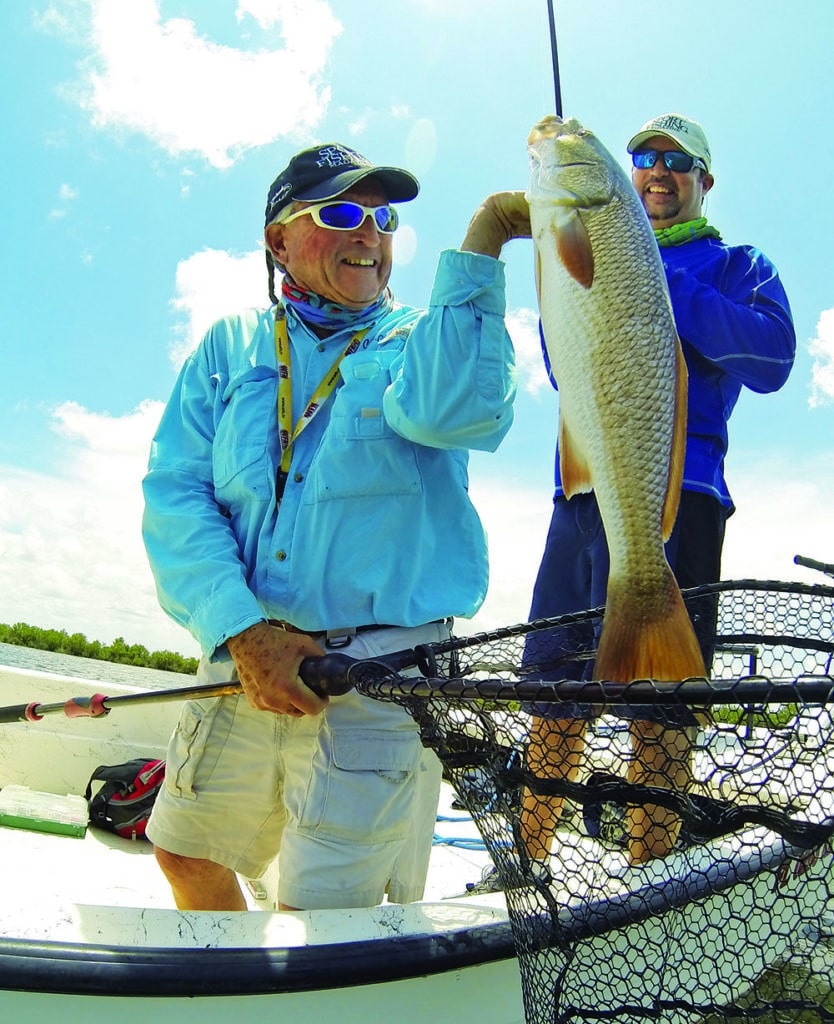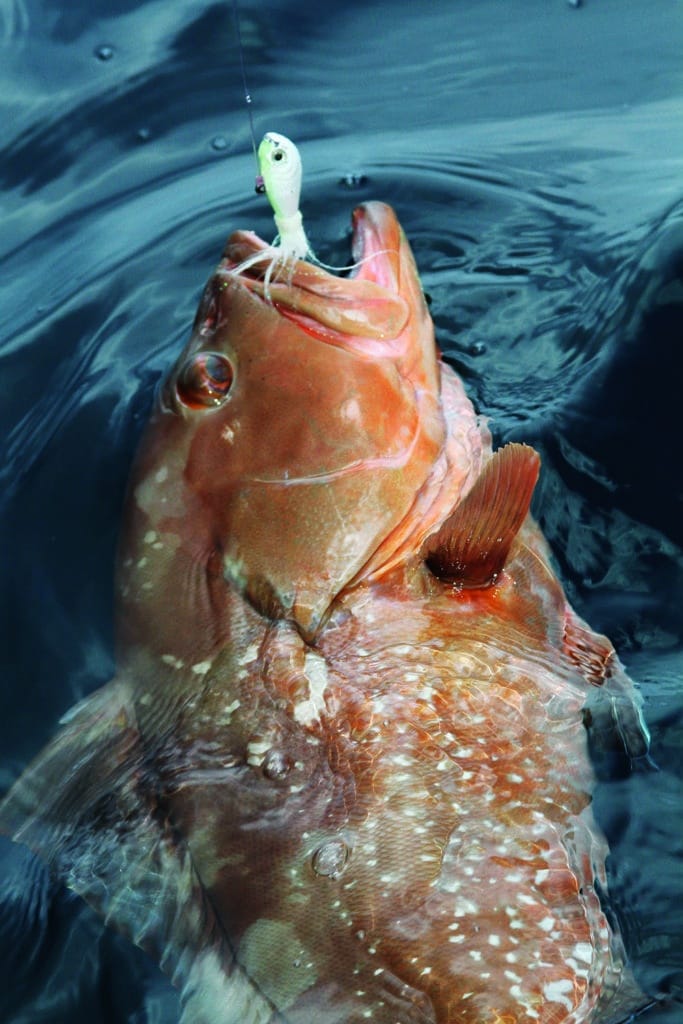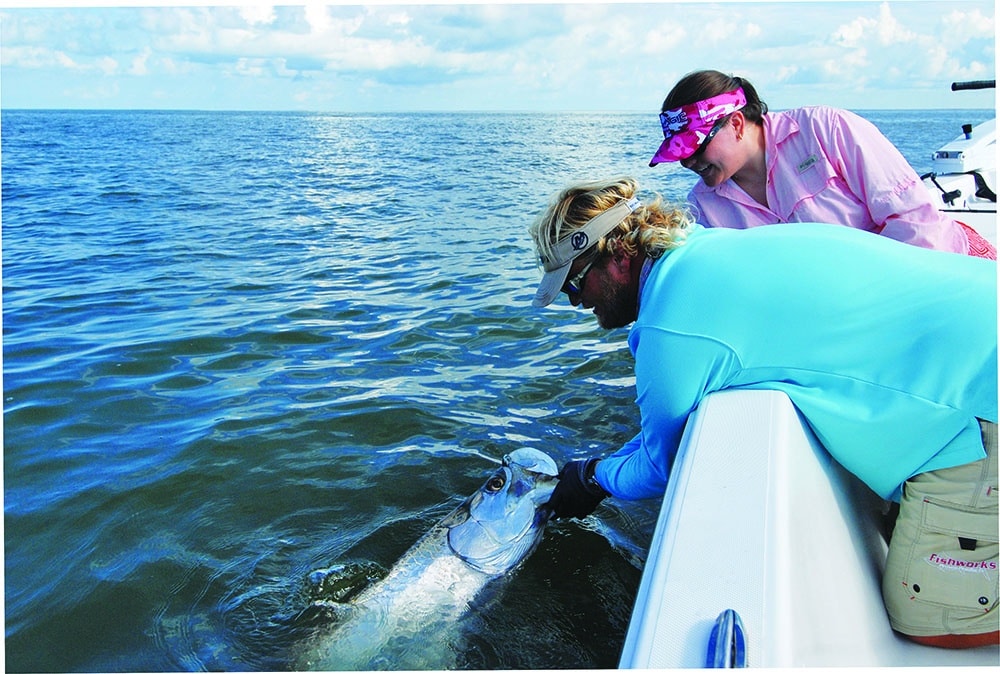Capt. William Toney poled his 23-foot custom Tremblay across the glassy, gin-clear flats near the mouth of the Crystal River. As he edged ever closer to a rolling school of 60-pound tarpon, Sport Fishing editor-in-chief Doug Olander and I crouched low in the bow. “Aim for the lead fish,” Toney whispered as Olander and I both fired soft-plastic jerk baits ahead of the school. Unfortunately, the fish were spooky, the result of trailing bull sharks, we surmised. Despite several tries, no takers.
Yet just as we were giving up, an incoming text brightened our morning. Managing editor Stephanie Pancratz had just landed her first tarpon — a 50-pounder — only 3 miles to our north while fishing with Capt. Dan Clymer aboard his custom 24-foot Pro-Line Bay.
Tarpon fishing opportunities in the Crystal River region of Florida’s Gulf Coast often get second billing to the legendary silver king fishery in Homosassa Bay to the south. Yet the Crystal River area offers great fishing for tarpon in its own right, according the fishing guides who know this area best.
We decided to see for ourselves. Using the Plantation on Crystal River resort and marina as a base, the Sport Fishing staff spent three days this past June sampling the angling opportunities of this picturesque region — and we had a ball.
Beyond tarpon, we caught redfish and seatrout around the myriad islands, reefs, grass flats, and channels fed by the idyllic Crystal River and its tributaries. But that’s not all. We also ventured offshore and discovered outstanding fishing for grouper and more.
SEATROUT CENTRAL
A vast network of grass flats extends west — as well as north and south — from the mouth of the Crystal River, and these are prime habitats for spotted seatrout, particularly in spring and fall, according to Crystal River-based guide Capt. Don Chancey, who fishes with a customized 24-foot Carolina Skiff, Flats Chance. “In February, March and April, we get some quality trout,” Chancey reveals. “These are fish in the 18- to 20-inch range.”
Our midsummer trip was not timed to the peak of seatrout action, but we still managed to catch and release some decent specimens using a variety of methods. Chancey likes to use an egg-shaped Cajun Thunder popping cork with a 2 ½-foot leader of 20-pound-test fluorocarbon and a quarter-ounce lead-head with a soft-plastic bait such as a MirrOlure 4-inch Soft Minnow in pinfish or mullet patterns. His method is to drift over the flats as anglers cast and chug the cork poppers, targeting sandy potholes and the edges of the grass beds. “The idea is to give it a pop, and then wait 3 to 5 seconds before popping it again,” he explains. “The trout hear the commotion, and then attack the lure hanging below it.”
Chancey likes to use medium-action 7-foot spinning rods, with reels filled with 10-pound-test braid, tied to the upper end of the popping cork. Chancey will sample a number of flats in depths ranging from 2 to 6 feet in a day of fishing until he finds the schools of trout.
Other guides eschew poppers when fishing the same types of soft plastics, or turn instead to shallow-running, lipped crank baits. Such was the case when targeting trout with Toney, who focuses more on channel edges than grass flats to find the bigger trout. One of hottest trout lures on our trip was a Yo-Zuri Pins Minnow in the chartreuse-silver pattern.
REDFISH RIOT
South of Crystal River mouth lies a labyrinth of small limestone islands, cuts and creeks known collectively as the Suncoast Keys. This is redfish territory, and most guides agree that September is prime time for targeting big reds — fish up to 12 pounds or more — in this backcountry.
Local guide Capt. Gary Cox likes to use the trolling motor on his custom 24-foot Carolina Skiff, Slap Stik, to work along the jagged, oyster-studded edges and current-swept points of these islands while his angling guests cast and retrieve snagless spoons such as Capt. Mike’s Weedless Gold Spoon or Charlie’s Weedless Spoon. This technique has proved to be one of the most effective for big reds in fall.
Cox rarely stops moving, but rather he keeps working along the shore to give his guests fresh targets at which to cast. And sometimes targets abound. “In September, I’ve seen schools of 150 to 200 reds,” says Cox. “The fishing can be fantastic.”
Most guides suggest a medium-action spinning rod with 12- to 15-pound-test braid and a 2-foot 25- to 30-pound-test fluorocarbon leader for these redfish riots.
Not all guides fish with artificials for reds. When bites are scarce on the spoons, Chancey likes to anchor and float cut bait or whole dead shrimp with the current along the shorelines of the islands using the Cajun Thunder popping cork to keep the bait just above the gnarly bottom. There’s nothing like watching the float suddenly sink away and then locking up with a hard-charging red. Chancy uses circle hooks with a variety of cut baits, including mullet, ladyfish and lizardfish, as well as shrimp.
TARPON TANGO
Tarpon fishing along this coast spools up in May and June as schools of 50- to 80-pounders migrate and gather en masse in the beautiful clear waters over grass flats that extend west from the mouth of Crystal River.
For guides such as Capt. Dan Clymer, this is a game of sight-fishing and stealth. Once he spots a rolling school of tarpon from the elevated helm of custom Pro-Line, Clymer tries to get ahead of the fish. When he finds the fish in water deeper than 6 or 7 feet, he’ll use a bow-mounted trolling motor to parallel the school until his anglers are well within casting distance of the fish.
When the water is shallower, Clymer relies on the push pole to intercept tarpon. “Whether fly-casting or using spinning gear, you need to lead the school by several feet,” Clymer says. “Wait until the lure sinks a couple of feet, let the first fish or two swim by, and then begin your retrieve.”
The idea is to try to present the lure to the third or fourth fish behind the leader, because if you spook the lead fish, the whole school spooks, according to Clymer.
For fly-fishermen, he recommends a 12- or 13-weight rod with floating or intermediate fly line, and at least 300 yards of backing. The favorite fly for tarpon in this region is a black-and-purple Tarpon Toad.
Clymer’s favorite lure is D.O.A.’s Bait Buster with a green back and silver belly. This is the same lure that Sport Fishing‘s Stephanie Pancratz used to catch her first tarpon. Another lure that works well for Clymer is a Hogy 10-inch Doublewide in Amber or Bally Smoke, nose-hooked with a 7/0 live-bait hook. For throwing these lures, Clymer prefers fairly heavy spinning gear. (He uses a Shimano 8-foot Teramar extra-heavy rod with Shimano Spheros 8000 reel with 30-pound braid and a 6-foot-long, 80-pound fluorocarbon leader.)
COBIA COMBAT
Scattered among the sprawling flats and offshore waters that extend outward from the mouth of Crystal River are innumerable reefs. These limestone outcroppings serve as havens for small fish and other forage. Around May each year, they also become the haunts of cobia ranging from 15 to 50 pounds or more.
You can find such reefs in a wide range of depths — anywhere from 3 to 100 feet of water, according to Chancey, who likes to target this structure for cobia in late spring. His technique is to anchor about 50 to 75 feet up-current of a likely reef and lay down a chum line. This helps draw the powerful cobia away from the snag-infested reef, giving anglers a better chance of landing the fish.
To entice a bite, Chancey free-lines a pinfish back into the chum line. But this is not light-tackle fishing, as a hooked cobia will immediately try to bully its way back to the reef. To wage battle with Crystal River cobia, Chancey spools up a large spinning reel or medium conventional reel with 40- to 50-pound-test braid and a 3- to 4-foot 80-pound-test fluorocarbon leader. “You have to fish with a tight drag to keep them from getting to the reef where than can break off,” Chancey says.
MACKEREL MANIA
The Gulf waters of this region can teem with king mackerel, particularly in mid-April and May and again in October, whenever the water reaches around 68 to 69 degrees F, according to Capt. Clay Shindler, who runs offshore charters out of Crystal River aboard his World Cat 33T, Hang ‘Em High. “We find most of the kings 30 to 60 miles offshore around structure areas such as ledges and wrecks” says Shindler. “It can be really good for fish in the 20- to 30-pound range.”
He relies largely on two techniques to catch these fish.
One is to troll with lipped plugs. Shindler pulls two at once, at about 6 or 7 miles per hour: a shallow-runner such as a Rapala Floating Magnum 18 in the silver mackerel pattern and a deep-runner like Rapala’s X-Rap Magnum 30 in the mullet pattern. While we were not fishing either of the prime kingfish seasons, we managed to catch a king very quickly while trolling around a wreck on our trip in June.
Lightly chumming and drifting dead baits is even more effective if you want to catch a lot of king mackerel, Shindler reveals. “You don’t want too much chum in the water, or you will attract a lot sharks. We basically put out just a chunk or two of cut herring every minute or so,” he explains. “We then drift whole herring as bait with a 5/0 live-bait or treble hook.” An 8-inch piece of No. 5 or 6 bronze wire helps prevent cutoffs.
Whether trolling plugs or drifting bait, Shindler likes to use conventional gear such as a Shimano 7-foot Saragosa rod rated for 15- to 30-pound-test line with a Penn 320 GTi or Shimano Trinidad 30 reel spooled up with 30-pound-test monofilament for a bit of forgiving stretch when fighting a king mackerel.
GROUPER GALORE
The Sport Fishing staff experienced a wide-open bite on red grouper to 12 pounds about 34 miles offshore from Crystal River with Shindler and Capt. Zack Hoffman aboard Hang ‘Em High during our trip in June. The best seasons for grouper here are late spring/early summer and late October/November, according to Shindler, and we hit the first one of the year at its peak.
Our two-captain crew focused on rolling limestone bottom in 50 to 60 feet of water. “The bottom looks relatively flat on the fish finder,” Shindler observes, “but there are hills and valleys with coral outcroppings here and there. All you’re really looking for is a 3-foot change in depth; that can hold lots of fish.”
Schools of red grouper roam across the bottom in these offshore waters, so Shindler and Hoffman have developed a buddy system in which they share information between themselves and other captains to help keep track of the shifting biomass.
The hot lure for us was a 3-ounce chartreuse or red-and-white Spro bucktail jig tipped with a D.O.A. C.A.L. 5.5-inch soft-plastic jerk bait in shades such as gold rush, nite glow and tequila sunrise. Once we found an area that was holding fish, we drifted over it. The jigging technique called for letting the lure touch the bottom on each downstroke while sweeping the rod just above vertical on the upstroke. And we discovered we had to be ready on the upstroke because the red grouper nailed the jigs with a vengeance. While jigging, we also caught gag grouper, which were out of season during our trip, and a fair number black sea bass and grunts.
In fall, Shindler has found trolling to be another effective technique for grouper. He trolls deep-diving plugs such as the X-Rap Magnum 30, particularly for gag grouper, using the same tackle as when trolling for king mackerel.
For jigging, Shindler provided Shimano 8-foot Teramar extra-heavy-action spinning rods with Shimano Spheros 10000 spinning reels spooled with 50-pound-test braid. Shindler and Hoffman add a 4-foot, 60-pound-test fluorocarbon leader to each rig.
There are certainly other species of fish to be caught in this area, including flounder, pompano and snook. So the next time you’re considering a trip to Florida’s Gulf Coast, don’t overlook the Crystal River region. If your trip goes anything like ours, you’ll have a ball.
PLANTATION ON CRYSTAL RIVER
With a marina, launch ramp, picturesque grounds, world-class restaurant, poolside/riverside tiki bar, immaculately groomed 27-hole golf course, classic architecture, and 196 exquisitely appointed rooms, suites, and villas, the 50-year-old Plantation on Crystal River is a perfect base for fishing this region of Florida’s Gulf Coast.
Overlooking the spring-fed headwaters of Crystal River, the resort welcomes boaters and anglers. You can bring your own boat or charter a guided fishing trip, which is a great way to learn the waters and local angling techniques. You can book your charter through the resort, and captains will pick you up at the marina. The resort can also provide box lunches for your day on the water.
It is best to make your room reservations as far in advance as possible, for it’s not unusual for the Plantation to fill up, particularly in spring, fall and winter, as well as during the opening days of scallop season, which begins on July 1 in this area. Room rates start at around $99. To learn more, visit plantationoncrystalriver.com.
GUIDE SERVICES
The Homosassa Guides Association offers a charter referral service for anglers interested in sampling the great fishing and other on-water activities in and around Florida’s Crystal River region. We fished with six outstanding guides from the association.
Capt. Don Chancey
Flats Chance Charters
352-303-9399
Capt. Gary “G.T.” Cox
Slap Stik Charters
352-628-5419
Capt. Dan Clymer
Crystal River Fishing Charters
352-418-2160
Capt. Zack Hoffman
Back Country Blitz Charters
352-220-1184
Capt. Clay Shindler
Hang ’Em High Charters
fishingcharterscrystalriver.com
352-586-2748
Capt. William Toney
Homosassa Inshore Fishing Charters
352-621-9284
CRYSTAL RIVER SEASONS
Here are the best times of the year to fish for five key species in the waters outside the mouth of Crystal River:
Red grouper May/June and October/November
King mackerel April/May and October
Redfish September
Spotted seatrout February/March/April and October/November
Tarpon May/June
